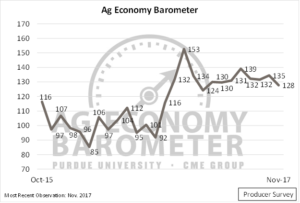Ag barometer: Producer sentiment slips following harvest
Note to journalists: The December Ag Economy Barometer Report will publish on Tuesday, January 9, 2018, due to Purdue University’s winter recess. Download the full reports schedule.
WEST LAFAYETTE, Ind. and CHICAGO – Producers expressed lower sentiment toward the agricultural economy in November on the heels of fall harvest, according to the Purdue University/CME Group Ag Economy Barometer.

The Ag Economy Barometer fell to 128 in November in what appears to be a post-harvest slump. This is the barometer’s second-lowest reading in 2017. (Purdue/CME Group Ag Economy Barometer/David Widmar)
The November barometer read 128, a 7-point decline from October’s 135 and the second-lowest reading of 2017. The barometer is based on a monthly survey of 400 agricultural producers from across the country.
“The November slide in sentiment was primarily driven by reduced optimism about the future,” said James Mintert, the barometer’s principal investigator and director of Purdue University’s Center for Commercial Agriculture. “We saw the Index of Future Expectations fall by 10 points, while the barometer’s other sub-index, the Index of Current Conditions, held steady at 129.”
In one of the survey questions, producers were asked whether they thought the next 12 months would be good times or bad times financially for the agricultural economy as a whole. Sixty-two percent said they thought the next 12 months will be bad times financially in U.S. agriculture. The percentage of producers expecting bad times in agriculture has been increasing since July when 50 percent of survey respondents said they were expecting bad times.
Throughout 2017, survey respondents have been asked about agricultural trade in an effort to understand how proposed policy changes might be impacting producer sentiment. When asked about the importance of agricultural exports to the overall U.S. agricultural economy, 96 percent rated them as important.
The survey also asked producers about the North American Free Trade Agreement (NAFTA).
“When we asked producers about NAFTA specifically, they were less confident about its importance to the U.S. agricultural economy,” Mintert said. “While 70 percent did rate it as important, a substantial 20 percent rated NAFTA as neutral, meaning neither important or unimportant.”
On a regular basis, the survey asks respondents about their expectations for farmland prices. For the first time in survey history, more producers said they expect higher farmland values than lower farmland values. Twenty-one percent said they expect farmland values to turn higher in the next 12 months, whereas 62 percent thought values would remain unchanged and 17 percent expect lower farmland values.
Read the full November report at http://purdue.edu/agbarometer. This month’s report includes additional information both sub-indices, farmland values and trade.
The Ag Economy Barometer, Index of Current Conditions and Index of Future Expectations are available on the Bloomberg Terminal under the following ticker symbols: AGECBARO, AGECCURC and AGECFTEX.
About the Purdue University Center for Commercial Agriculture
The Center for Commercial Agriculture was founded in 2011 to provide professional development and educational programs for farmers. Housed within Purdue University’s Department of Agricultural Economics, the center’s faculty and staff develop and execute research and educational programs that address the different needs of managing in today’s business environment.
About CME Group
As the world’s leading and most diverse derivatives marketplace, CME Group (www.cmegroup.com) is where the world comes to manage risk. Through its exchanges, CME Group offers the widest range of global benchmark products across all major asset classes, including futures and options based on interest rates, equity indexes, foreign exchange, energy, agricultural products and metals. CME Group provides electronic trading globally on its CME Globex platform. The company also offers clearing and settlement services across asset classes for exchange-traded and over-the-counter derivatives through its clearinghouses CME Clearing and CME Clearing Europe. CME Group’s products and services ensure that businesses around the world can effectively manage risk and achieve growth.
CME Group, the Globe logo, CME, Chicago Mercantile Exchange, Globex and E-mini are trademarks of Chicago Mercantile Exchange Inc. CBOT, Chicago Board of Trade, KCBT and Kansas City Board of Trade are trademarks of Board of Trade of the City of Chicago, Inc. NYMEX, New York Mercantile Exchange and ClearPort are trademarks of New York Mercantile Exchange, Inc. COMEX is a trademark of Commodity Exchange, Inc. Dow Jones, Dow Jones Industrial Average, S&P 500 and S&P are service and/or trademarks of Dow Jones Trademark Holdings LLC, Standard & Poor’s Financial Services LLC and S&P/Dow Jones Indices LLC, as the case may be, and have been licensed for use by Chicago Mercantile Exchange Inc. All other trademarks are the property of their respective owners.
Writer: Jennifer Stewart-Burton, 765-496-6032, jsstewar@purdue.edu
Sources: Jim Mintert, 765-494-4310, jmintert@purdue.edu
David Widmar, 765-494-0848, dwidmar@purdue.edu
Chris Grams, 312-930-3435, chris.grams@cmegroup.com
Related website:
Purdue University Center for Commercial Agriculture: http://purdue.edu/commercialag
CME Group: http://www.cmegroup.com/
Photo Caption:
The Ag Economy Barometer fell to 128 in November in what appears to be a post-harvest slump. This is the barometer’s second-lowest reading in 2017. (Purdue/CME Group Ag Economy Barometer/David Widmar)
A publication quality photo is available at: https://news.uns.purdue.edu/images/2017/mintert-november.jpg


